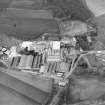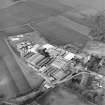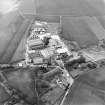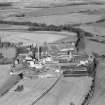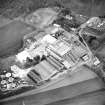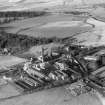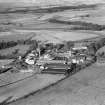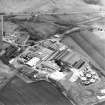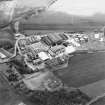Kilbagie Mill
Distillery (18th Century), House (18th Century), Office (20th Century), Paper Mill (19th Century)
Site Name Kilbagie Mill
Classification Distillery (18th Century), House (18th Century), Office (20th Century), Paper Mill (19th Century)
Alternative Name(s) Gestetner Paper's Ltd; Ja Weir; Invrsek Fine Papers; Stein's Distillery
Canmore ID 238620
Site Number NS99SW 67
NGR NS 92844 90028
Datum OSGB36 - NGR
Permalink http://canmore.org.uk/site/238620
- Council Clackmannan
- Parish Clackmannan
- Former Region Central
- Former District Clackmannan
- Former County Clackmannanshire
2-storey and attic 4-bay traditional house. Harled with painted margins to front, rubble rear. Off-centre door, 3 ground floor windows, 4 symmetrically placed to 1st floor. Central wallhead gable with 1 window
and apex stack. Coped end stacks, slate roof, scrolled skewputts. (Historic Scotland)
Kilbagie Mill was orginally a distillery founded in the later 18th century. It was converted to a paper mill in 1874. (Gifford & Walker)
External Reference (9 December 2019)
Kilbagie Through the Years
1707 - Union of Parliaments
early 1700s - New Excise Duty based on the size of the still imposed. Excisemen found it difficult to collect.
c.1720 - Whisky Distillery owned by John Stein founded at Kilbagie. Whisky mostly exported to London market.
1751 - Margaret Stein , daughter of John Stein married John Haig. There were 5 sons, all apprentices at Kilbagie.
1773 - Kilbagie recognised as Scotland's biggest distillery.
1787 - Kilbagie whisky mentioned in Robert Burn's poem' The Jolly Beggars'.
1814 - New Custome Duty imposed -minimum size of stills to be 500 gallons.
This led to Customs closing down thousands of small and mainly illicit stills all over Scotland.
1823 - Further legislation passed requiring distilleries to have a licence, after which nearly all illicit stills were stamped out.
1826 - Robert Stein invented the patent still.
c.1850 - popularity of gin, particularly in London, caused the financial collapse of the Kilbagie enterprise.
1866 - The Kilbagie Chemical Manure co. Ltd was formed for the manufacture and sale of fertiliser.
1871 - Esparto grass imported to manufacture esparto pulp for sale to Paper Mills in Scotland.
1875 - Papermaking started by JA Weir and Mr Watson.
1896 - Limited company formed known as JA Weir Ltd.
c.1922 - Gestetner became company of JA Weir Ltd.
1964 - making pulp from esparto grass ceased.
1965 - Gestetner purchased the Share Capital of JA Weir Ltd and mill modernisation commenced.
1969 - The name of the company was changed from JA Weir Ltd to Gestetner papers Ltd.
1987 - business acquired by the The Pratt Group of Melbourne, Australia and trading started under the name of Weir paper Products Ltd.
1994 - opening of de-inking plant.
1995 - Weir Paper Products Ltd by Inveresk PLC, with the creation of the Fine Papers Division in November.
1997 - Inveresk Fine Papers Division became Inveresk Graphic Papers September.
HES: MS 8201 (Inveresk information sheet c.1997)























